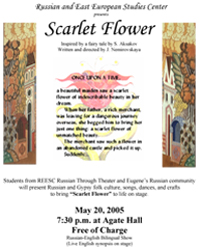The REESC Russian Through Theater class along with members of Eugene’s Russian community studied Russian and Gypsy folk culture, songs, dances, and crafts in order to bring “The Sacrlet Flower” to life on stage. The play was inspired by a fairy tale by Sergei Aksakov. Aksakov’s story is a 19th century rendition of the Russian folk tale, “Beauty and the Beast.”
Note from Julia Nemirovskaya, the play’s writer and director:
“This timeless story, about fearless love that transforms ugliness into beauty, varies from culture to culture, as does the idea of beauty itself. The Russian word for beautiful (krasivyi) derives from “red” (krasnyi), which was considered the most beautiful of all colors. And the Russian word for “bad” (khudo) comes from “thin” (khudoi), which means that Russians thought only corpulent people were beautiful. To fight the battle against the slim waistline, Russian noblewomen would lay in bed, taking special treatments of milk, honey, and vodka (along with lots of snacks, of course) in order to nurture the soft, round shape that they so coveted. To set off their full-figured beauty, Russian women painted their faces white, their teeth black, and finished this dramatic look with one red circle on each plump cheek. Despite the differences in standards of beauty over time and across cultures, there is a universal side to beauty. Everyone appreciates the beauty of a flower. There can be something in a look, a gesture, a form, or a voice, which is almost indefinable but nonetheless recognized as beautiful. This universal aspect of beauty allows people of all cultures to understand each other and, in the end, brings them closer together. Perhaps this was what the great Russian novelist, F. Dostoevsky, meant when he wrote his enigmatic phrase: ‘Beauty will save the world.’”

